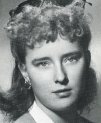
Venerable Teresita Gonzalez-Quevedo
Her secret was Mary - 1
Sister Mary Elizabeth
 |
Venerable Teresita Gonzalez-Quevedo Her secret was Mary - 1 Sister Mary Elizabeth |
[Published in From the House Top - The Slaves of the Immaculate Heart of Mary,
Still River, Massachusetts, USA, 2004, pp.1-20.] - Website:
www.saintbenedict.com.
Madrid, Spain, 1930 -- The hammer and sickle strikes Spain -- Madrid life resumed -- Sodality and Slavery
Madrid, Spain-1930
Once upon a time, the Catholic people of the world banded together, bearing the Cross upon their shields, and formed Crusades to win back the sacred places and religious artifacts that were dear to them. Trudging to the area of conflict, they suffered intensely privations and wounds, and many even gave their very lives for the cause.
Today the Spiritual Holy Land of the Catholic Church is in crisis, and because of this, the Holy Land of the Family is also in an alarming state. The cure for these crises does not consist in calling in crafty politicians, providing more educational opportunities, or creating more cash flow to establish economic equilibrium.
"Holiness is the thing", Father Faber once said. Saints are the special friends of God who reflect the holiness of God. Saints defy the world, the flesh, and the Devil. Saints are true Crusaders who battle with God and for God. We need saints to take back the family and the Catholic Church; we need a Crusade of Holiness.
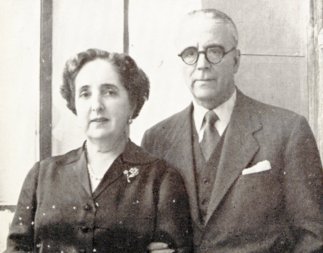 |
Here before you lies a story which deeply contrasts the problems of today's modern world, yet it shows subtle, but very real sanctity in action. One year after 20-year-old Teresita passed into eternity, a Spanish biography of her life went to press. The Bishop of Ciudad Rodrigo wrote the preface of the book.
In it he said: "The book which you have in your hands is not one to leaf through and set aside for someone else to read. That God has placed it in your hands should be sufficient to assure you that there is something in it written just for you.
If you are a man, prepare yourself to enter into a beautiful and chaste feminine world. If you are a father, the intimacy of the authentic Christian family sketched on there pages will delight you. If you are a woman... there are a million things in this book for you. If you are a young girl, walking the same path as that of Teresita, it will fascinate you.
If you are a young religious, you could be the protagonist. Whoever you are, read to the end and you will learn how a holy and happy young girl finds God."
This Spanish Bishop knew the effectiveness of example. Sanctity is better understood when we see it in action before us. The place of the story is Spain and the year is 1930, just preceding the hellish Civil War. The personae of the story are from the Quevedo family: Dr. Calixto, his wife, Dona María, and their three children, Luis, Carmen, and Teresa, the lovely Spanish rose, who blossomed within this family garden. Her name in full is Maria Teresa Josefina Justina Gonzalez-Quevedo, and she has been honored by the Catholic Church with the title of Venerable.
One can see of what mettle Teresita was made in one particular incident. It seemed that a teenage acquaintance confided to her that she was thinking of becoming a religious, with the stipulation, however, that she would first enjoy herself when she was young, and then when youth had disappeared, she would then seek admission into a convent so as to assure her eternal salvation.
Horrified, Teresita responded, "What an egotist you are!... After you've given the best of yourself to the world! Jesus has good taste, you know, and He wants youth with all its joys and its dreams." Teresita did not believe in giving Our Lord leftovers. Even at ten years of age at the academy's retreat for girls, she wrote, "I have decided to became a saint." It was the "I decided" part that made Teresita what she was. She stubbomly focused on this goal of sanctity and never turned back.
Born on Holy Saturday, in Madrid, April 14, 1930, Maria Teresa was the daughter of Calixto Quevedo, a prominent physician, known for his skill in the arts of healing and for his charity. Her educated mother was the granddaughter of the Admiral Luis Cadarso y Rey, who died during a battle in 1898, aboard the Queen Cristina.
During the Catholic persecution of the turbulent Spanish Civil War, Spain witnessed six members of the Quevedo family who gave their lives for their Faith. Teresita's lineage was replete with souts of skill, intelligence, and strength, and even martyrs.
Despite the virtuous lineage, however, Teresita was not born with wings and a halo. She could not be crossed without a reaction, and many times her will was at variance with those around her and often her hot temper got her into trouble.
Teresita soon became known as "Venenito" (little Poison), because of her mischievousness. However, her disarming smile and playful ways made her the favorite of all. It took time to tame that unruly, stubborn will of hers through the patient and constant vigilance of those around her. Stubbornness can be guided and bent the right way. Saints were stubborn.
Teresita began her spiritual life in an atmosphere that breathed the Catholic Faith in all its beauty and joy. Lovely representations of our holy Faith by way of statues and pictures were found tastefully placed throughout the house. Every evening the family gathered for the Rosary before a beautiful wood-carved statue of the Immaculate Conception.
Our Lady had revealed to Saint Dominic that "The Rosary shall make virtue and good works flourish," and how true it was for this family. This love of Our Lady's chaplet became Teresita's daily practice from the age of five. She taught her nurse and the cook to say it, as well as her friends at school. When she was at the academy, she made it a practice to say the Sorrowful Mysteries every day before the Blessed Sacrament. Another promise to Saint Dominic was that "Those who propagate my Rosary shall obtain aid in all their necessities." How truly Teresita experienced this assistance and guidance of the Mother of God throughout her life.
The Quevedo parents not only encouraged the outward devotions of their Faith, they truly lived their Faith. The children were very young when both parents taught their children catechism and prayers. Calixto especially delighted in teaching Teresita, whom he instructed to began her day with this prayer: "O sweet Virgin Mary, my Mother, I offer myself today completely to you. I beg you to give my body, eyes, ears and tongue, my heart and soul to Jesus. I am all yours, holy Mother of God. Watch over me!"
"From early childhood, when Papa taught me to make the Morning Offering - Teresita reminisces - it was always a prayer of holocaust to Our Lady." Thus, the powerful spiritual tool of a happy, spiritual home launched Teresita's journey toward holiness through total consecration to Mary.
The hammer and sickle strikes Spain
The Quevedos lived across from Madrid's Royal Palace, until Teresita was about seven years old. When the Spanish Civil War erupted, blood flowed in the streets of Catholic Spain through the hands of Communists, and many feared for their lives. At that point, Calixto thought it best for his family to head north where they had a second family home.
It was safer to be there until order was restored to their country. However, because Calixto was such a prominent Catholic physician, he had to go into hiding, separate from the family, with his whereabouts unknown to them. First he stayed at a friend's house, and then later at the French Embassy.
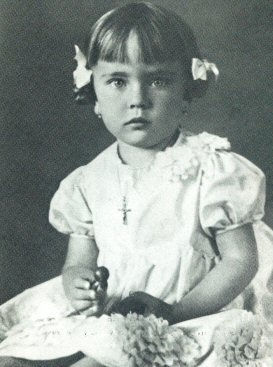 |
at three years of age |
Stories of the frightening persecution reached the Quevedo family, with horrific tales of 7.000 priests, thirteen bishops, and many thousands of laymen and women murdered within three years. This war claimed six members of Calixto's family, three of his own brothers: Manolo, an engineer; Teresita's godfather, José, a lawyer; and Francisco, a university student. They were among the many that paid for their love and fidelity to Christ the King and His Church with their very blood. After sixteen months away from his family, Calixto rejoined them amidst great rejoicing.
The Quevedo's stay at their summer home in Santander, on the Cantalabrian seacoast, was different from what they were used to. Unlike the elegant and comfortable surroundings of Madrid's Royal Palace, the poor frequented their play areas which was a rather shocking difference for Teresita.
The six-year-old did not like the little urchins she saw and was repulsed by their dirt and rude ways, so unlike the etiquette and refined manners which she was taught. Calixto immediately corrected this fault in his daughter by pointing out that these little ones were poorer than Baby Jesus Himself, and because of that, God the Father loved them very much. He also reminded her that they were Catholic children just like her, and probably prayed their Morning Offering to Our Lady as she did.
Though only a child herself, Teresita grew in wisdom and virtue and gradually began to overcome her repulsion. She soon made friends with them, and invited them to her house. She taught them to wash their hands and faces, and to use a napkin after she treated them to hot chocolate. Teresita also collected toys and clothing to give to her new acquaintances. Calixto was unrelentingly diligent in forming his child's character according to Christ's mind, helping her to make correct judgments and to see the spiritual side in situations.
The Civil War brought further changes to the Quevedo family. Calixto had to take on a father's role to his martyred brother's seven young children, making sure they were taken care of physically and spiritually. Because of social unrest, Teresita was not able to receive formal instruction for First Holy Communion. One of Calixto's brothers, Father Antonio Quevedo s.j., gave her father permission to teach the necessary classes at home.
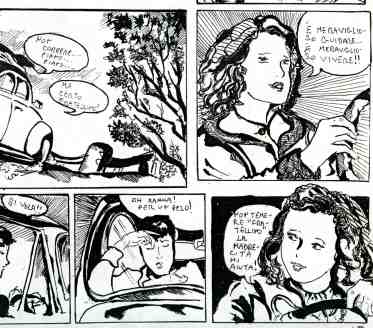 |
with the help of his brother. [Design of Amelia Ippolito] |
Her cousin Oscar, also Teresita's age, joined in the classes. Calixto spoke to his "students" about Jesus, their greatest Friend, and in fact, their only True Friend. He told them about many saints, virgins, and martyrs who gave their lives for Jesus. These stories were very real to them, having martyrs within their very family, and hearing firsthand about similar heroic acts of fellow countrymen on almost a daily basis.
When the long-awaited day of July 29, 1937, arrived, Teresita wore a simple white voile dress and the customary long white lace veil. Her cousin Oscar, who wore a white linen suit, accompanied her to the altar rail. Father Antonio gave them Jesus in their First Holy Communion.
This day marked a transition in her life that was apparent to everyone for three reasons: she became remarkably more humble, she began to take correction better, and she never intentionally missed going to daily Mass. She later revealed that it was during the precious moments when she received Our Lord for the first time, that she chose His Mother as her sole confidante. From the day of her First Holy Communion, Jesus and Mary were now more firmly linked in the spiritual chain of Teresita's soul. It was evident that Venenito was a nickname that no longer fit.
Madrid life resumed
A few years passed and in Spain, under the leadership of Franco, life slowly resumed as normal a course as was possible in those days. In the summer of 1939, the Quevedo family returned to their home in Madrid. With the fresh memories of the martyrs before her, Teresita received the sacrament of Confirmation November 9, 1939, and, now fortified by the Holy Spirit, desired to give her life as a witness to Our Lord, and become a martyr if that was what He wished. A new era of her life was about to began.
It was time for school and serious study. Luis, Teresita's older brother by three years, enrolled with the Jesuits while she and her older sister, Carmen, were day students at Our Lady of Mount Carmel Academy, taught by the Institute of the Carmelite Sisters of Charity. Her paternal aunt, Mother Teresa, was the Prefect of Discipline as well as a teacher there.
Teresita was very gifted intellectually but did not have a natural liking for books, and it was a continual challenge for her to keep at her studies. She worked hard and achieved such good grades that many students sought her assistance. "She gave it generously to everyone, regardless. The girls throughout the academy loved her," said her classmates. She overcame her natural disinclination to studies to such an extent that she did all her assignments neatly, learned quickly, and received high grades.
She preferred art and excelled in it, especially drawing. Her artistic taste extended to the way she dressed and carried herself. She actually received an award for "Best Dressed" in the school. Teresita loved the academy and enjoyed the social and academic challenges offered to her there. The academy was in fact a great instrument in helping Teresita, attain holiness through the discipline and spiritual guidance that it offered.
The Jesuits who worked closely with the academy enriched students and religious with many spiritual benefits, especially drawing from Saint Ignatius and his Spiritual Exercises, and especially encouraging devotion to the Blessed Sacrament and Our Lady.
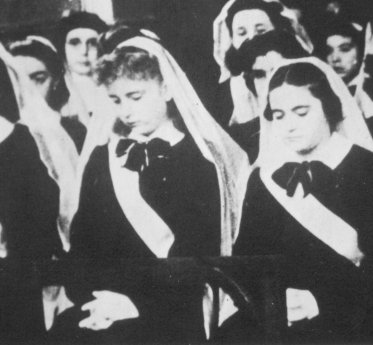 |
consecration in the Our Lady's Sodality, December 13, 1944. |
When Teresita was ten, she and some of the girls made a retreat. Even at that young age, she made a very mature and definite decision. In her retreat notebook she wrote the words: "I have decided to become a saint." La Madrecita, as Teresita began to call Our Lady, became everything to her and students began to notice certain changes in her.
Yes, she was still mischievous and vivacious, but during the month of Our Lady, May, there seemed to be another side of Teresita. She became more silent, self-sacrificing, intent on offering herself in little acts of generosity. The Sisters made that month especially festive with lovely May shrines and competition amongst the students for best behavior.
During that month there was a special ten-minute reading by one of the girls during the noonday meal. Usually a student had to be appointed to the disliked task, but Teresita found it a good opportunity for a sacrifice to offer to her Madrecita and she would often joyfully volunteer. These little sacrifices reflected her determination.
Sodality and Slavery
At thirteen she strengthened her spiritual life by accepting the invitation of the Sisters to join the Sodality of Our Lady. After studying its demanding requirements, she readily accepted the challenge and on December 13, 1944, she consecrated herself entirely to Our Lady as her slave according to the spirit of Saint Louis Marie de Montfort.
Each sodalist received a medal and chose for herself the motto that she wished to have inscribed on it. Teresita decided on: "Mother, grant that everyone who looks at me may see You." This Sodality of Our Lady became another ladder along her upward climb toward sanctity. The first rule of the organization stated: "As many as are gathered under this title of Our Lady must be true Christians who sincerely strive for sanctification in their respective state of life, and who work with earnest determination, as far as their social condition permits, to save and sanctify souls."
These high ideals helped the young ladies prepare for whatever walk of life God called them, whether it would be the religious or the lay state. Teresita later was elected President of the Sodality, because of her zeal and contagious enthusiasm in promulgating its goals.
At sweet sixteen, life was wonderful, exciting, and full of beauty for Teresita. Her brother, Luis, taught her to drive the family car. This caused her father concern and distress, because she liked to speed! Besides driving, she enjoyed shopping with friends, looking at clothes and beautiful art.
She would also often enjoy a good movie, and one of her favorites at that time was "The Song of Bernadette." Many times at the end of a walk she would stop to console the elderly who were cared for by the Little Sisters of the Poor, and on occasion she entertained them with her singing and Spanish dancing. She had become so proficient at her native cultural dance that her instructor stated that she could have danced professionally.
Teresita loved to be with others her own age. She was quite attrattive, yet young men realized she was mystifyingly aloof and resolute in her behavior. This dashing young lady was a bit of a puzzle to them.
Madrid, Spain, 1930 -- The Hammer and Sickle strikes Spain -- Madrid life resumed -- Sodality and Slavery -- A Vow of Chastity -- The Catholic in Action -- "We play for Championship!" -- The decision -- Last Days with the Family -- The Postulant -- The Novice -- Code of Amiability -- "If the Madonna wishes it" -- The Holy Year of Pius XII -- The Cross -- Extreme Unction and Final Vows -- On the Cross -- "For Him alone I lived!" -- The Glory
|
|

|
Home Page |
St. Joseph Moscati's magazine: |